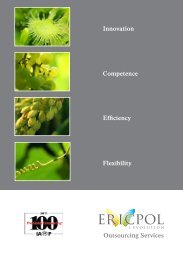Practical ICT Experience – Flexibility – Worldwide References
Practical ICT Experience – Flexibility – Worldwide References - Ericpol
Practical ICT Experience – Flexibility – Worldwide References - Ericpol
Create successful ePaper yourself
Turn your PDF publications into a flip-book with our unique Google optimized e-Paper software.
Knowledge Evolution<br />
Design of Safety-Critical Systems & Software<br />
Course ID: EPOL-10:024<br />
Duration: 2 or 3 days<br />
Number of participants: recommended optimum 15, maximum 25<br />
Course objectives<br />
The primary goal of this course is to give the participant the skills necessary to design software for<br />
real-time and embedded computer systems in which faults and failures could pose a danger to human<br />
life. This is a very practical, results-oriented course that will provide knowledge and skills that can be<br />
applied immediately.<br />
This course examines the design of embedded systems and software that are to provide services in applications<br />
that could, when they fail, threaten the well-being or life of people. It offers practical guidance on<br />
how to address safety concerns when designing safety critical software in fields such as medical, automotive,<br />
avionics, nuclear and chemical process control.<br />
The course surveys concepts and alternatives for software and system architectures appropriate for<br />
safety-critical systems. Following an examination of hazard and risk analysis techniques, it goes on to list<br />
a number of approaches to software safety that span fault avoidance, fault detection, and fault containment<br />
tactics including redundancy, recovery, masking and barriers. A variety of candidate architectural<br />
design patterns are examined, including dual/triple modular redundancy, dissimilar independent<br />
designs, backup parallel patterns and active/monitor parallel patterns. Many real-world examples are<br />
presented. Software design approaches are discussed for run-time Built-In Self Test (BIST) of processor<br />
and peripheral hardware.<br />
This course is far from a general course about system or software design theory, but rather it is tightly<br />
focused on the design of embedded systems and software that are required to provide their intended<br />
functions without endangering the safety or life of users or their environment.<br />
V/17 ericpol.com



